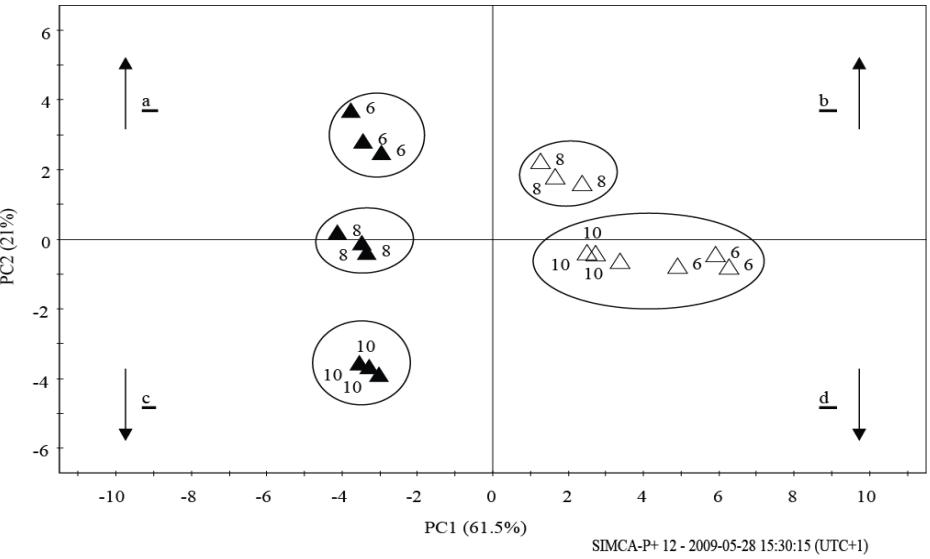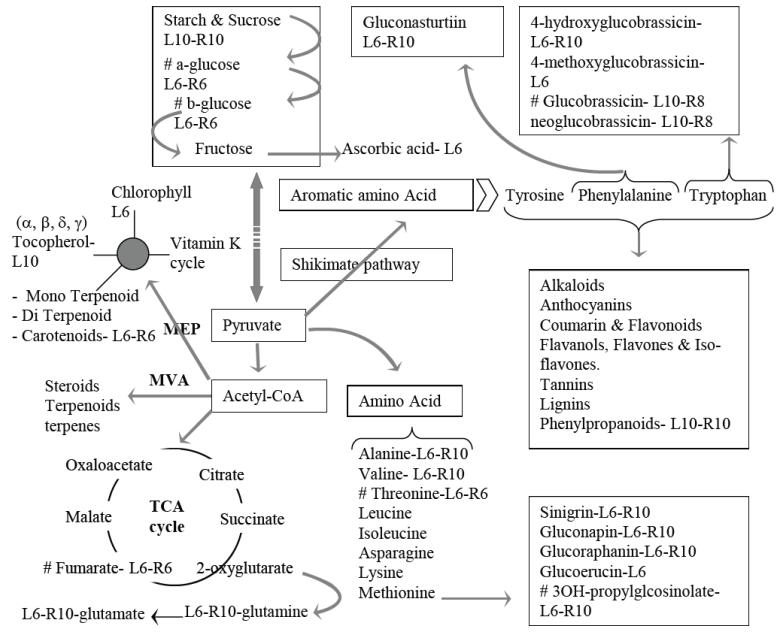What is Brassica rapa?
Brassica rapa, a botanical wonder, belongs to the Brassicaceae family and is commonly recognized as field mustard, turnip rape, or turnip. Originating in Western Europe and Western Asia, this adaptable plant has made its presence felt across diverse ecosystems globally. With its various subspecies, Brassica rapa has emerged as a pivotal model organism in the realm of plant biology, offering profound insights into essential facets such as plant development, evolution, and metabolism.
Our Brassica rapa Metabolomics Analysis Projects
At Creative Proteomics, our commitment to advancing scientific knowledge is exemplified through our Brassica rapa Metabolomics Analysis projects. Each project is meticulously designed to extract detailed insights into the metabolic composition of Brassica rapa, contributing to the broader understanding of plant biology.
Targeted Metabolite Identification:
Utilizing state-of-the-art mass spectrometry techniques, our projects focus on the identification and profiling of specific metabolites within Brassica rapa. This includes organic acids, amino acids, lipids, and secondary metabolites, offering a detailed view of the plant's metabolic fingerprint.
Pathway Mapping and Analysis:
Beyond individual metabolites, our projects delve into the intricate web of metabolic pathways within Brassica rapa. Through sophisticated data analysis, we map the interconnected pathways, providing a comprehensive understanding of how metabolites interact and contribute to the plant's overall metabolic landscape.
Dynamic Quantitative Metabolomics:
Our projects employ quantitative metabolomics to capture the dynamic changes in metabolite concentrations over time or under different conditions. This quantitative approach enhances the precision of our analysis, enabling a deeper exploration of Brassica rapa's metabolic dynamics.
Customized Solutions for Research Objectives:
Recognizing the unique goals of each research endeavor, our Brassica rapa Metabolomics Analysis Projects are customizable. Whether your focus is on specific metabolites, pathways, or experimental conditions, we tailor our projects to align seamlessly with your objectives, ensuring a targeted and impactful analysis.
Methodology and Analytical Techniques for Brassica rapa Metabolomics
Liquid Chromatography-Mass Spectrometry (LC-MS):
LC-MS is a cornerstone technique in our Brassica rapa Metabolomics Analysis. The Agilent 1290 Infinity II LC System, coupled with the high-resolution Agilent 6550 iFunnel Q-TOF LC/MS, allows for the separation and identification of a broad range of metabolites. This system offers exceptional sensitivity and accuracy, enabling in-depth profiling of Brassica rapa's metabolome.
Gas Chromatography-Mass Spectrometry (GC-MS):
GC-MS is employed for the analysis of volatile and semi-volatile compounds within Brassica rapa. The Thermo Scientific TRACE™ 1310 GC, coupled with the high-resolution Thermo Scientific Q Exactive™ GC Orbitrap™ MS, provides unparalleled capabilities in resolving complex mixtures, offering insights into the volatile fraction of Brassica rapa metabolites.
Nuclear Magnetic Resonance (NMR) Spectroscopy:
NMR spectroscopy is harnessed to elucidate the structural and compositional details of key metabolites in Brassica rapa. The Bruker Avance III HD 600 MHz NMR Spectrometer provides high-resolution spectra, facilitating the precise identification of metabolites and contributing to a comprehensive understanding of the plant's metabolic landscape.
High-Performance Liquid Chromatography (HPLC):
HPLC is a versatile technique utilized for the separation and quantification of diverse compounds. Our Brassica rapa Metabolomics Analysis integrates the Waters Alliance e2695 Separations Module with the Waters Xevo TQ-S micro Mass Spectrometer, offering robust performance in profiling the metabolites present in Brassica rapa.
 Workflow for Metabolomics Service
Workflow for Metabolomics Service
Sample Requirements for Brassica rapa Metabolomics
| Sample Type |
Recommended Quantity |
Sample Processing |
Quality Control Standards |
Data Analysis Workflow |
| Leaf Extract |
50 mg |
Describe the method for leaf extraction. |
Internal standards are used to ensure quality. |
After data acquisition, process using XCMS. Include peak picking, alignment, and normalization. |
| Root Extract |
75 mg |
Specify the root extraction method. |
Quality control involves checking for consistency using known standards. |
Data is processed with a focus on feature extraction and statistical analysis. |
| Flower Extract |
30 mg |
Clearly outline the flower extraction process. |
Utilize both internal and external standards for quality assurance. |
Data analysis includes identification of significant features and pathway analysis. |
| Seed Extract |
60 mg |
Explain the extraction steps for seeds. |
Employ a range of QC measures including replicates and blanks. |
Emphasize on statistical analysis and metabolite identification. |
| Stem Extract |
40 mg |
Detail the method for stem sample processing. |
QC involves checking instrument performance with known standards. |
Comprehensive data analysis including statistical validation of results. |
| Whole Plant Extract |
100 mg |
Describe the extraction procedure for whole plant samples. |
Regularly run standards to monitor system stability. |
Implement a robust data processing pipeline, including multivariate analysis. |
Deliverables
Detailed Metabolite Reports: In-depth profiles of identified metabolites, including structural information and concentration levels.
Metabolic Pathway Maps: Visual representations of Brassica rapa's metabolic pathways, highlighting key nodes and interactions.
Quantitative Metabolomics Data: Precise data on metabolite concentrations, enabling quantitative analyses and dynamic comparisons.
Customized Project Summaries: Tailored summaries that encapsulate the project's findings in a format accessible to diverse audiences.
Case. Metabolomic Profiling of Brassicaceae Vegetables at Various Developmental Stages: Insights into Nutritional Dynamics
Background
Brassica vegetables, including Raphanus sativus (red radish) and Brassica rapa (var. raapstelen), are renowned for their nutritional compounds. This study focuses on understanding the metabolomic changes in these vegetables during different developmental stages, crucial for assessing their health-promoting potential.
Samples
Seeds of Raphanus sativus and Brassica rapa were germinated, and plants were cultivated in controlled conditions. Harvesting was conducted at 6, 8, and 10 weeks of age, encompassing crucial developmental phases.
Technological Methods
Plant Growth Conditions: Seeds underwent germination and were later transferred to a greenhouse under specific light-dark conditions.
Sample Preparation: Harvested plants were meticulously washed, dried, and separated into roots and leaves for subsequent analysis.
NMR-Based Metabolomic Assessment: A non-targeted metabolite analysis using NMR involved sample preparation, analysis, and data processing. Identification and quantification of various compounds, including amino acids, organic acids, and sugars, were accomplished.
HPLC-Based Analysis: Ascorbic acid, chlorophyll, carotenoids, tocopherols, and glucosinolates were assessed using HPLC. Different extraction and detection methods were applied for each compound.
Data Analysis: Principal Component Analysis (PCA) was employed for data analysis, comparing results obtained from NMR and HPLC.
Results
Identified Metabolites: A range of metabolites, including amino acids, organic acids, carbohydrates, phenylpropanoids, ascorbic acid, chlorophyll, carotenoids, tocopherols, and glucosinolates, were identified and quantified in both Brassica and Raphanus.
Quantitative Differences: Young leaves exhibited higher levels of several metabolites compared to older leaves, indicating age-dependent changes. This pattern was observed in both roots and leaves.
Inter-Species and Inter-Varietal Comparisons: Variations were noted between Brassica rapa and Raphanus sativus, with each species exhibiting distinct metabolic profiles.
Age-Dependent Changes: Generally, a decrease in glucosinolate content with increasing plant age was observed, while specific glucosinolates showed temporary fluctuations.
Nutritional Implications: Young plants were identified as superior sources of nutrients and health-promoting compounds, emphasizing the importance of plant age in determining nutritional value.
 Score plot of PCA for Brassica rapa (var. Raapstelen) and Raphanus sativus (radish) roots (B), based on whole range of 1 HNMR signals (δ 0.3 – δ 10.0) and HPLC data
Score plot of PCA for Brassica rapa (var. Raapstelen) and Raphanus sativus (radish) roots (B), based on whole range of 1 HNMR signals (δ 0.3 – δ 10.0) and HPLC data
 Change in metabolite quantities during plant growth.
Change in metabolite quantities during plant growth.
Reference
- Jahangir, Muhammad, et al. "Metabolomic variation of Brassica rapa var. rapa (var. raapstelen) and Raphanus sativus L. at different developmental stages." Pakistan Journal of Botany 46.4 (2014): 1445-1452.


 Workflow for Metabolomics Service
Workflow for Metabolomics Service Score plot of PCA for Brassica rapa (var. Raapstelen) and Raphanus sativus (radish) roots (B), based on whole range of 1 HNMR signals (δ 0.3 – δ 10.0) and HPLC data
Score plot of PCA for Brassica rapa (var. Raapstelen) and Raphanus sativus (radish) roots (B), based on whole range of 1 HNMR signals (δ 0.3 – δ 10.0) and HPLC data Change in metabolite quantities during plant growth.
Change in metabolite quantities during plant growth.

